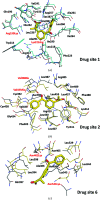Organism-specific differences in the binding of ketoprofen to serum albumin
- PMID: 36071810
- PMCID: PMC9438504
- DOI: 10.1107/S2052252522006820
Organism-specific differences in the binding of ketoprofen to serum albumin
Abstract
Serum albumin is a circulatory transport protein that has a highly conserved sequence and structure across mammalian organisms. Its ligand-binding properties are of importance as albumin regulates the pharmacokinetics of many drugs. Due to the high degree of structural conservation between mammalian albumins, nonhuman albumins such as bovine serum albumin or animal models are often used to understand human albumin-drug interactions. Ketoprofen is a popular nonsteroidal anti-inflammatory drug that is transported by albumin. Here, it is revealed that ketoprofen exhibits different binding-site preferences when interacting with human serum albumin compared with other mammalian albumins, despite the conservation of binding sites across species. The reasons for the observed differences were explored, including identifying ketoprofen binding determinants at specific sites and the influence of fatty acids and other ligands on drug binding. The presented results reveal that the drug-binding properties of albumins cannot easily be predicted based only on a complex of albumin from another organism and the conservation of drug sites between species. This work shows that understanding organism-dependent differences is essential for assessing the suitability of particular albumins for structural or biochemical studies.
Keywords: NSAIDs; anti-inflammatory drugs; drug interactions; drug transport; human serum albumin; ketoprofen; organism-dependent studies.
© Mateusz P. Czub et al. 2022.
Figures






Similar articles
-
Structural investigations of stereoselective profen binding by equine and leporine serum albumins.Chirality. 2020 Mar;32(3):334-344. doi: 10.1002/chir.23162. Epub 2020 Jan 6. Chirality. 2020. PMID: 31905261
-
Role for Carboxylic Acid Moiety in NSAIDs: Favoring the Binding at Site II of Bovine Serum Albumin.Mol Pharm. 2024 May 6;21(5):2501-2511. doi: 10.1021/acs.molpharmaceut.4c00044. Epub 2024 Apr 4. Mol Pharm. 2024. PMID: 38574292
-
Differential modulation in binding of ketoprofen to bovine serum albumin in the presence and absence of surfactants: spectroscopic and calorimetric insights.Chem Biol Drug Des. 2013 Jul;82(1):81-98. doi: 10.1111/cbdd.12136. Chem Biol Drug Des. 2013. PMID: 23517326
-
Serum Albumin, Lipid and Drug Binding.Subcell Biochem. 2020;94:383-397. doi: 10.1007/978-3-030-41769-7_15. Subcell Biochem. 2020. PMID: 32189308 Review.
-
Serum albumins-unusual allergens.Biochim Biophys Acta. 2013 Dec;1830(12):5375-81. doi: 10.1016/j.bbagen.2013.06.016. Epub 2013 Jun 26. Biochim Biophys Acta. 2013. PMID: 23811341 Free PMC article. Review.
Cited by
-
Revisiting and Updating the Interaction between Human Serum Albumin and the Non-Steroidal Anti-Inflammatory Drugs Ketoprofen and Ketorolac.Molecules. 2024 Jun 24;29(13):3001. doi: 10.3390/molecules29133001. Molecules. 2024. PMID: 38998953 Free PMC article.
-
To bind, or not to bind, that is the question….IUCrJ. 2022 Sep 1;9(Pt 5):536-537. doi: 10.1107/S2052252522008685. eCollection 2022 Sep 1. IUCrJ. 2022. PMID: 36071803 Free PMC article.
-
Structural and biochemical characterisation of Co2+-binding sites on serum albumins and their interplay with fatty acids.Chem Sci. 2023 May 23;14(23):6244-6258. doi: 10.1039/d3sc01723k. eCollection 2023 Jun 14. Chem Sci. 2023. PMID: 37325156 Free PMC article.
-
Improved Frontal Gel Filtration Chromatography to Examine the Interaction between Small Molecules and a Protein with Multiple Specific Binding Sites.ACS Omega. 2025 Apr 15;10(16):15979-15988. doi: 10.1021/acsomega.4c07939. eCollection 2025 Apr 29. ACS Omega. 2025. PMID: 40321540 Free PMC article.
-
Synthesis of Novel Benzothiazole-Profen Hybrid Amides as Potential NSAID Candidates.Molecules. 2024 Dec 30;30(1):107. doi: 10.3390/molecules30010107. Molecules. 2024. PMID: 39795166 Free PMC article.
References
-
- Acharya, M. R., Sparreboom, A., Sausville, E. A., Conley, B. A., Doroshow, J. H., Venitz, J. & Figg, W. D. (2006). Cancer Chemother. Pharmacol. 57, 275–281. - PubMed
-
- Bi, S., Yan, L., Sun, Y. & Zhang, H. (2011). Spectrochim. Acta A Mol. Biomol. Spectrosc. 78, 410–414. - PubMed
-
- Bohnert, T. & Gan, L.-S. (2013). J. Pharm. Sci. 102, 2953–2994. - PubMed
Grants and funding
LinkOut - more resources
Full Text Sources

